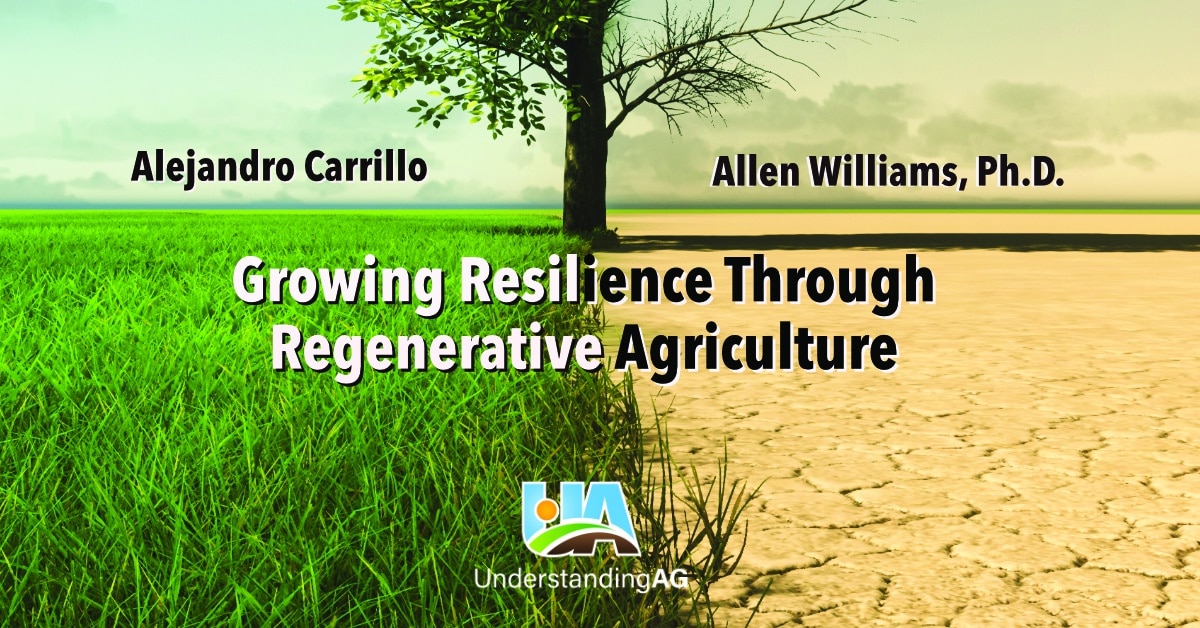
What are the key factors for building climate resiliency? How can each of us participate in that endeavor? In our October article, we shared examples from the Chihuahuan Desert that illustrated how regenerative practices can significantly improve productivity and resiliency in such an arid environment. We received quite a few comments on that article, but one that stood out was from a former special forces soldier who served in Vietnam. He wrote, “In the delta of Vietnam everything was wet, but there were a few places that were dramatically less so. Those places tended to be old French plantations that were mono-cropped for decades.”
How we manage matters. In Conquest of the Land Through 7000 Years, W.C. Lowdermilk’s writes, “….the land does not lie; it bears a record of what men write on it…..a record that is easy to read by those who understand the simple language of the land.” Our management is written on the tapestry of the land—and it ultimately determines the land’s resiliency.
Let’s explore the key factors that contribute to our land’s resiliency to climate and weather. They are not hard to understand and implement.
- Building soil biology – Building the biology of the soil, rather than tearing it down, is the single most important thing we can do to create climate resiliency. In modern agriculture, we have too often done damage to the soil and the living creatures within that soil. Those living creatures are the key to our livelihood, our profitability, our health, and the health of the climate. Everything else emanates from first building soil biology.
- Improving soil aggregate structure – This cannot be accomplished without first building soil biology. Soil aggregates, created in large part by microbiological activity, allow for far greater water infiltration and retention. The beautiful thing about aggregated soil is that soil type does not matter. All soils can be aggregated. Additionally, improved water infiltration creates climate resiliency whether we are too wet or too dry.
- Increasing plant species diversity – Increasing the diversity of plant species in our fields and pastures greatly speeds up the progress we can make in building soil biology and improving soil aggregatation. More diversity increases the variety of root exudates produced by the plants and this attracts a much broader array of soil microbial species.
- Integrating proper animal impact – Adaptive grazing allows us to build greater plant species diversity and to build soil biology and aggregate much more quickly. There is no other form of grazing that even comes close to the positive impact of adaptive grazing. Leaving plenty of plant residual material behind after each grazing is crucial to protecting the soil biology and plant species diversity. Failure to do so results in collapse of soil biology and the soil aggregate.
Rain-Creating Compounds
In October’s article, we discussed the role that microbes play in helping create precipitation. Another pathway is through Biological Volatile Organic Compounds (BVOCs). These consist of monoterpenes emitted by plants which rise into the atmosphere where they collide with hydroxy radicals and form secondary organic aerosols (SOA). The SOAs, just like microbes going airborne, serve as nuclei to facilitate precipitation through the ice nucleation process.
Additionally, the BVOCs interact with nitrogen oxides to precipitate hydroxy radical formation. The hydroxy radicals collide with trace gases in the atmosphere, including methane (CH4). The methane is eventually broken down to CO2 and vaporized H2O. The CO2 is cycled via photosynthesis and the Calvin cycle into glucose and carbon metabolites that are used by the plants.
We should not forget that plants also transpire water vapor. The SOAs catalyze rain through both plant transpiration and hydroxyl oxidation of methane.
Why is this important and how does it relate to the key factors above? For the atmospheric microbial seeding and the action of BVOCs, SOAs, and transpired water vapor to be effective, it takes healthy soils and plant species diversity and density. The system feeds itself. Implement practices that build healthy soils, and you get far greater water infiltration and retention. This leads to better plant growth. Better plant growth means increased water transpiration, more microbial release into the atmosphere and more BVOCs and SOAs. With poor management, there is significantly less transpired water, BVOCs, SOAs, and ultimately, less rain.
Let’s take a look at several specific examples of how regenerative principles and practices make a difference in resiliency:
North Dakota
In a four-farm comparison of neighboring farms, we found that regenerative principles made a big difference in the ability of each farm to grow soil organic matter (SOM) and enhance water infiltration rate. The table below illustrates the differences between the four farms based on their management practices. Farm #4 was managed regeneratively and far exceeded the three neighboring farms in SOM and water infiltration rates.
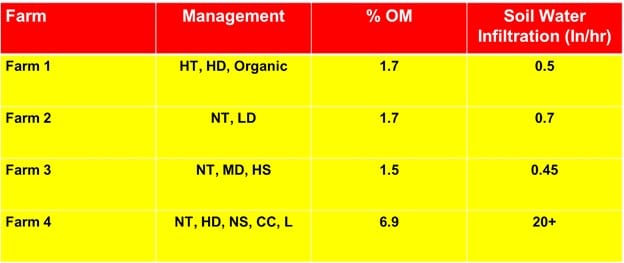
HT = Conventional Tillage, NT – No-Till, LD = Low Diversity, MD = Moderate Diversity, HS = High Synthetics, NS = No Synthetics, CC = Cover Crops, L = Livestock.
The region has been in a six-year drought with extreme to exceptional drought in 2021. The picture below (Picture 1) is of a cow on Farm #4 that has been through six years of drought and is still in outstanding body condition. The high SOM, coupled with significantly higher water infiltration rates, have allowed Farm #4 to sustain production and cow BCS in spite of the climate challenges (this cow was not supplemented and has never missed a calf).
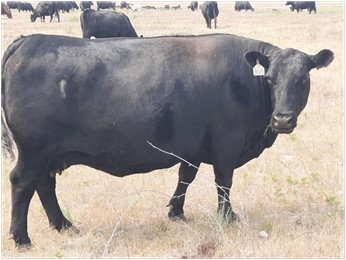
North Carolina
Another example of resiliency comes from a farm located in the eastern coastal plains of North Carolina, owned by Adam Grady. In just their second full year of regenerative agriculture (2018), they faced two significant challenges. First, flooding rains during the month of April and May, followed by Hurricane Florence in September of 2018.
Pictures 2 and 3 show the difference between corn fields relative to management practices. Picture 2 was of the regeneratively managed field and Picture 3 of a conventionally managed field directly adjacent to each other. Both fields were planted in the first week of April 2018. Field 2 had to be replanted because the first planting failed due to the excessive rainfall. Field 2 did not have to be replanted. Field 1 had a complex cover crop mix growing through the prior fall and winter. The corn was planted using a no-till drill in a rolled down cover crop. Field 2 was tilled multiple times to prepare for planting.
The pictures were taken the last week of May 2018. Water can be seen still standing in Field 2 while no water was standing water in Field 1. Field 1 yielded 53 more bushels at harvest, compared to Field 2. Field 1 used 75% less fertilizer with significantly fewer passes made through the field to prepare, plant and harvest.
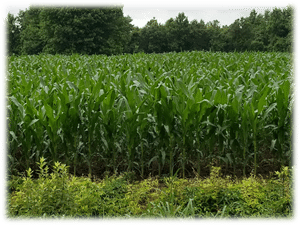
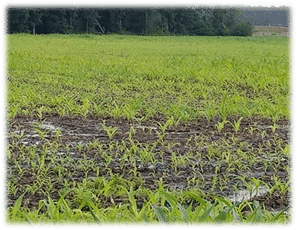
In September, the farm also experienced Hurricane Florence. Florence dumped more than 35 inches of rain on the region creating significant flooding across a wide area. Adam experienced flood waters of up to nine feet deep across a majority of his farm. Picture 4 shows what portions of the farm looked like on the second day of the hurricane.
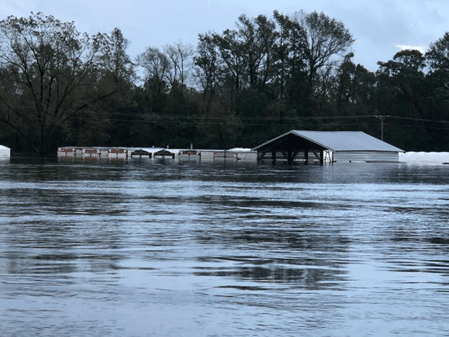
Luckily, Adam was able to get his corn crop harvested prior to the hurricane making landfall. However, his soybean crop and pasture crops were lost due to being covered by the flood waters for more than five days. Picture 5 shows the condition of his pastures after the flood waters receded.
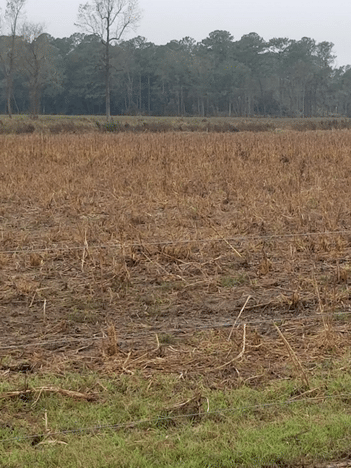
This type of resiliency came into play after the flood waters fully receded. Just two weeks after the hurricane, Adam was able to get his tractors and no-till drills into the field and plant a complex cover crop. His neighbors saw him doing this and tried to get into their fields but their tractors quickly sank in the mud and muck.
The cover crops seemed to explode out of the soil with incredible vigor. Within two weeks they were several inches tall with remarkable density. Adam was able to start grazing his livestock again in just a few weeks and had grazing throughout the winter. His neighbors had little-to-no grazing and had to either de-stock or feed supplemental hay and feedstuffs all winter.
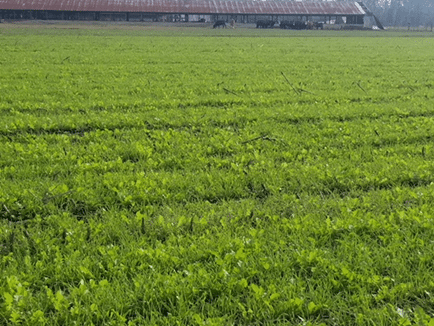
Summary
Climate resiliency is certainly possible with application of the Six Principles of Soil Health and Adaptive Stewardship. In examining three farms from three distinct regions of North America (Chihuahuan Desert, North Dakota, North Carolina), we’ve documented significant resiliency regardless of whether we were dealing with a desert environment, the northern great plains or the coastal plains of the eastern seaboard.
The tools we can use to build resiliency on our land and in our operations are unquestionably effective and increasingly well documented. Now, it’s up to us to put those tools to work.
Reference: A biogenic secondary organic aerosol source of cirrus ice nucleating particles
